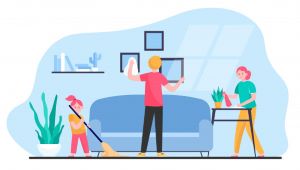
Poisoning
We all know that innocent children are curious and we need to protect them from harm. Accidental poisoning causes 5,000 preventable deaths annually in America. You can prevent your family from experiencing such a horrible event by:
- ensuring harmful substances and cleaning products, including those colorful tempting laundry/dishwasher pods, are kept in high cupboards out of reach from little hands
- storing pesticides and paint products in locked areas that aren’t accessible to children
- never leaving your child alone in the kitchen
- never storing hazardous products in food containers as children may think it’s okay to consume them
- having the poison control center contact in your cell phone for emergencies
Carbon monoxide (CO) poisoning can occur when using non-electrical fuel-burning appliances in confined spaces. According to the National Center for Environmental Health of the Centers for Disease Control and Prevention (CDC), 50,000 Americans are treated annually for carbon monoxide poisoning resulting in more than 400 deaths. Read our DomiDocs tips for Carbon Monoxide Prevention in Your Home.
Drowning
Did you know children between one and four years of age can drown in only two inches of water? Tragically in America, there are 800 deaths by drowning annually. Swimming and wading pools are obvious culprits but so are bathtubs, toilets, and using electrical items unsafely in a bathroom. Children must always be supervised in any of these situations to prevent any further tragedies. If you do have an outdoor pool, there will be municipal or state bylaws you’ll need to follow which may include ensuring there’s a barrier around the perimeter, childproof latches, pool covers, and/or alarms on gates or doors leading to the pool area.
Secure Sharp Objects
While we all have sharp objects in and around our homes, we can prevent them from getting in the hands of little ones by storing them safely. This applies to scissors, kitchen knives, graters, and lawn maintenance equipment such as mowers, saws, rakes, and other garden tools. But this also applies to your dishwasher especially since items are at the perfect height for little eyes and hands; place blades and prongs of cutlery to face downwards to help avoid any nasty cuts.
Firearms
State and federal regulations apply to the storing of firearms and ammunition within your home. The C.S. Mott Children’s Hospital in Michigan says that unfortunately “firearm injuries are among the top four causes of death for children ages 10–24, with homicide by a firearm being a leading cause of death in children ages 1–9.” They offer the following gun safety tips:
- keep guns unloaded
- keep guns locked up
- store the ammunition in both a locked and separate area away from any guns
- never tell children of any age where the keys are kept
If your child will be visiting a neighbor, enquire if the family has any firearms in the house and as to how they’re stored. They also recommend discouraging the overall use of pellet, toy, and BB guns with children so they never confuse an actual gun for a toy one.
Trips & Falls
It’s so easy for anyone in your home to unexpectedly trip on something and fall causing bodily injury and unfortunately falls are the number one cause of death in relation to home accidents. Do a quick 5-minute clean-up daily around your home to pick up any toys, clothing, pillows, or other objects that may get strewn about. It’s also important to secure electrical cords and rugs so you don’t trip when simply walking by. Minimize the risk of falls on stairs by keeping them clear of clutter, securing them with childproof gates if necessary, and periodically checking to see that the steps and handrails are solidly attached. Ensure your walkways are kept ice-free during winter and always wipe up any spills immediately in your kitchen and bathrooms.
Mold
Dampness anywhere in your home including your basement, bathrooms, plants, and the attic, can produce unwanted and unhealthy mold problems. If you find any leaks, you’ll need to attend to them quickly so water damage and mold don’t occur. Cleaning up spills as they happen, along with regularly sanitizing your kitchen and bathroom helps to eliminate any potential mold hazards. The Centers for Disease Control and Prevention (CDC) suggests to always ensure your home has good airflow and maintains a humidity level no higher than 50%.
Ladders
A fall-related injury study by the CDC showed 62% of fall-related injuries were between the ages of 20 and 49, while 43% of injuries were attributed to falls from ladders. Always be certain a ladder is placed on level ground, never attempt to stand on the top two ladder rungs, and don’t overreach even though it’s tempting.
Choking & Suffocation Hazards
Everyone knows children love to put things in their mouths so parents and caregivers must be especially attentive to prevent accidental choking. Toys with small parts, small button-like batteries from electronics, and food/candy that’s too large can all impose a choking hazard. Ensuring you know how to administer the Heimlich maneuver on a small baby or toddler is absolutely essential if you’ve got children running about. To help prevent suffocation from occurring with small children, always keep plastic bags stored away and make certain all electrical cords and strings from blinds are secure.
Fire Hazards
According to the National Fire Protection Association, fire departments responded to home fires every 93 seconds across America in 2019 resulting in more than $7 billion in property damage. Besides having smoke, carbon monoxide, and radon gas detectors throughout your house, you’ll need to test them all monthly and replace the batteries in the spring and fall using daylight saving time as a reminder. Industry experts also recommend having at least one A-B-C-rated fire extinguisher on each floor of your home including the basement, garage, and kitchen. Establishing an out-of-home meeting place and regularly practicing a fire escape plan is vital to keeping you and your family safe as the Red Cross states you may have as little as two minutes to escape your home. Other fire hazards in your home could include smoking, matches and lighters, accumulated dryer lint, space heaters, unattended burning candles, and/or faulty Christmas tree lights. Read our DomiDocs Fire Safety Resources for Homeowners.
Tipping Hazards
Children love to explore but you need to be aware of potential tipping hazards around your home to keep them safe. Most tipping-type injuries in a home occur in family rooms, living/dining areas, and bedrooms, according to the Consumer Protection Agency of the Government of Western Australia, but children around the world are all inquisitive just the same. Unstable furniture such as a heavy big-screen TV, chests of drawers, wardrobes, desks, and chairs, are the most common furniture items to topple over. What to do? Anchor any heavy furniture around your home to prevent accidental tipping resulting in injury.
Burns
A child can receive significant burns from trying to access something on a stove if they’re left unattended if even for a moment. Sometimes they’re attracted by the smell of the food or maybe by the sizzling action they can hear. Either way, it’s important to ensure:
- your stove is securely installed
- you use the back burners instead of the front as it’s more difficult for children to access
- you turn all pot/pan handles to face inwards so they can’t be grabbed or accidentally knocked over
DomiDocs is committed to helping make your life as a homeowner the best it can be. Sign up with HomeLock® today and you’ll get immediate home protection along with a comprehensive 7-year property scan report!
Author – Connie Motz



